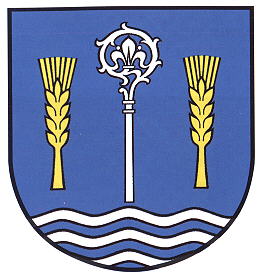Münsterdorf: Difference between revisions
Knorrepoes (talk | contribs) No edit summary |
Knorrepoes (talk | contribs) m (Text replace - "[[Literature" to "{{media}} [[Literature") |
||
| Line 22: | Line 22: | ||
The early medieval name of the village was Welanao, or Wellenau. In 822 Ebo, Archbishop of Reims, founded a small monastery in the village as a station for his missionaries. Later Ansgar, Archbishop of Hamburg founded a small church in the village. The name gradually changed to Münster (from monasterium, monastery). The arms show in the base some waves (for Wellenau, Welle=wave, and the Stör river) and a crosier for the two archbishops. The two wheat ears symbolise the agricultural character of the village. | The early medieval name of the village was Welanao, or Wellenau. In 822 Ebo, Archbishop of Reims, founded a small monastery in the village as a station for his missionaries. Later Ansgar, Archbishop of Hamburg founded a small church in the village. The name gradually changed to Münster (from monasterium, monastery). The arms show in the base some waves (for Wellenau, Welle=wave, and the Stör river) and a crosier for the two archbishops. The two wheat ears symbolise the agricultural character of the village. | ||
{{media}} | |||
[[Literature]] : Reissmann, 1997 | [[Literature]] : Reissmann, 1997 | ||
Revision as of 01:57, 9 July 2014
| Heraldry of the World Civic heraldry of Germany - Deutsche Wappen (Gemeindewappen/Kreiswappen) |
MÜNSTERDORF
State : Schleswig-Holstein
District (Kreis) : Steinburg
Amt : Amt Breitenburg
Official blazon
Über silbernen und blauen Wellen in Blau ein silberner Krummstab zwischen zwei begrannten goldenen Ähren.
Origin/meaning
The arms were officially granted on July 18, 1990.
The early medieval name of the village was Welanao, or Wellenau. In 822 Ebo, Archbishop of Reims, founded a small monastery in the village as a station for his missionaries. Later Ansgar, Archbishop of Hamburg founded a small church in the village. The name gradually changed to Münster (from monasterium, monastery). The arms show in the base some waves (for Wellenau, Welle=wave, and the Stör river) and a crosier for the two archbishops. The two wheat ears symbolise the agricultural character of the village.
Contact and Support
Partners:
Your logo here ?
Contact us
© since 1995, Heraldry of the World, Ralf Hartemink 
Index of the site
Literature : Reissmann, 1997











